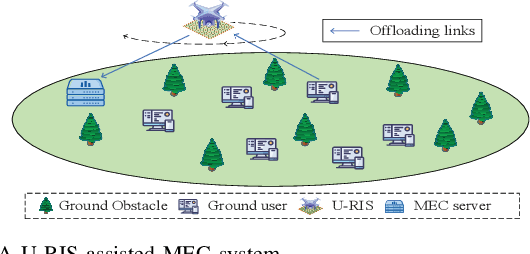Zhiyuan Zhai
UAV-Enabled Asynchronous Federated Learning
Mar 11, 2024Abstract:To exploit unprecedented data generation in mobile edge networks, federated learning (FL) has emerged as a promising alternative to the conventional centralized machine learning (ML). However, there are some critical challenges for FL deployment. One major challenge called straggler issue severely limits FL's coverage where the device with the weakest channel condition becomes the bottleneck of the model aggregation performance. Besides, the huge uplink communication overhead compromises the effectiveness of FL, which is particularly pronounced in large-scale systems. To address the straggler issue, we propose the integration of an unmanned aerial vehicle (UAV) as the parameter server (UAV-PS) to coordinate the FL implementation. We further employ over-the-air computation technique that leverages the superposition property of wireless channels for efficient uplink communication. Specifically, in this paper, we develop a novel UAV-enabled over-the-air asynchronous FL (UAV-AFL) framework which supports the UAV-PS in updating the model continuously to enhance the learning performance. Moreover, we conduct a convergence analysis to quantitatively capture the impact of model asynchrony, device selection and communication errors on the UAV-AFL learning performance. Based on this, a unified communication-learning problem is formulated to maximize asymptotical learning performance by optimizing the UAV-PS trajectory, device selection and over-the-air transceiver design. Simulation results demonstrate that the proposed scheme achieves substantially learning efficiency improvement compared with the state-of-the-art approaches.
Decentralized Federated Learning via MIMO Over-the-Air Computation: Consensus Analysis and Performance Optimization
Oct 08, 2023Abstract:Decentralized federated learning (DFL), inherited from distributed optimization, is an emerging paradigm to leverage the explosively growing data from wireless devices in a fully distributed manner.DFL enables joint training of machine learning model under device to device (D2D) communication fashion without the coordination of a parameter server. However, the deployment of wireless DFL is facing some pivotal challenges. Communication is a critical bottleneck due to the required extensive message exchange between neighbor devices to share the learned model. Besides, consensus becomes increasingly difficult as the number of devices grows because there is no available central server to perform coordination. To overcome these difficulties, this paper proposes employing over-the-air computation (Aircomp) to improve communication efficiency by exploiting the superposition property of analog waveform in multi-access channels, and introduce the mixing matrix mechanism to promote consensus using the spectral property of symmetric doubly stochastic matrix. Specifically, we develop a novel multiple-input multiple-output over-the-air DFL (MIMO OA-DFL) framework to study over-the-air DFL problem over MIMO multiple access channels. We conduct a general convergence analysis to quantitatively capture the influence of aggregation weight and communication error on the MIMO OA-DFL performance in \emph{ad hoc} networks. The result shows that the communication error together with the spectral gap of mixing matrix has a significant impact on the learning performance. Based on this, a joint communication-learning optimization problem is formulated to optimize transceiver beamformers and mixing matrix. Extensive numerical experiments are performed to reveal the characteristics of different topologies and demonstrate the substantial learning performance enhancement of our proposed algorithm.
Energy-Efficient UAV-Mounted RIS Assisted Mobile Edge Computing
Mar 24, 2022

Abstract:Unmanned aerial vehicle (UAV) and reconfigurable intelligent surface (RIS) have been recently applied in the field of mobile edge computing (MEC) to improve the data exchange environment by proactively changing the wireless channels through maneuverable location deployment and intelligent signals reflection, respectively. Nevertheless, they may suffer from inherent limitations in practical scenarios. UAV-mounted RIS (U-RIS), as a promising integrated approach, can combine the advantages of UAV and RIS to break the limit. Inspired by this, we consider a novel U-RIS assisted MEC system, where a U-RIS is deployed to assist the communication between the ground users and an MEC server. The joint UAV trajectory, RIS passive beamforming and MEC resource allocation design is developed to maximize the energy efficiency (EE) of the system. To tackle the intractable non-convex problem, we divide it into two subproblems and solve them iteratively based on successive convex approximation (SCA) and the Dinkelbach method. Finally we obtain a high-performance suboptimal solution. Simulation results show that the proposed algorithm significantly improves the energy efficiency of the MEC system.
 Add to Chrome
Add to Chrome Add to Firefox
Add to Firefox Add to Edge
Add to Edge